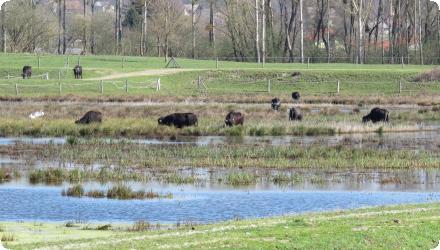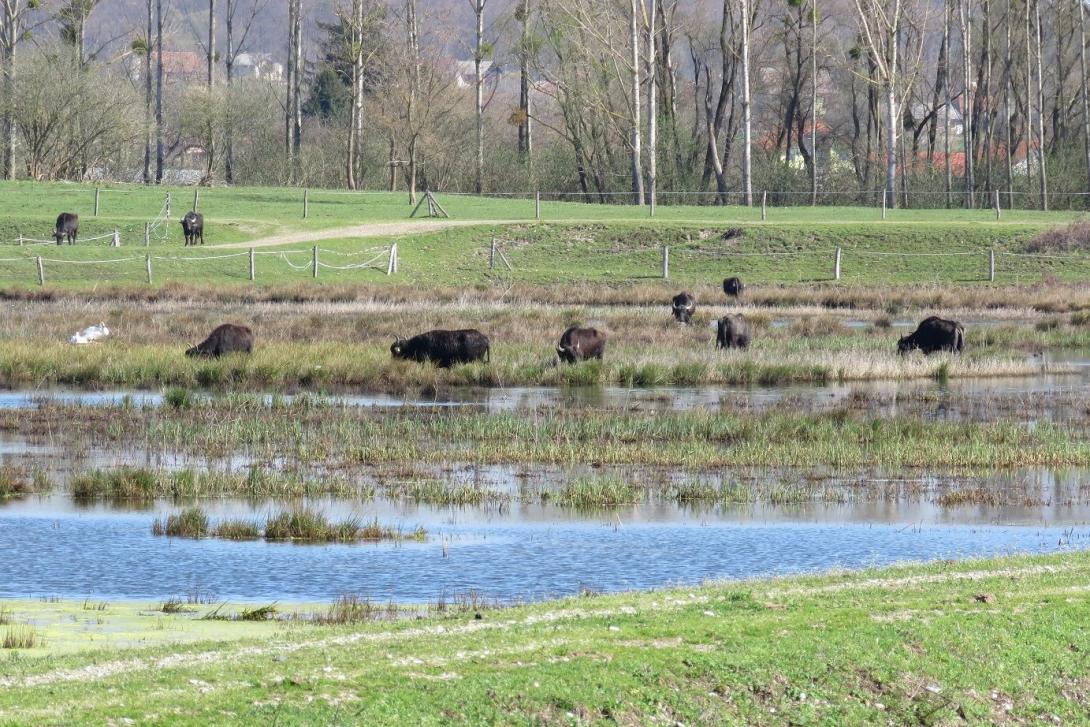Last update
2025
Summary
The LIVEDRAVA project, funded by the LIFE programme, transformed 61 ha of former wastewater basins at the Ormož sugar factory into semi-natural wetlands on the Drava River in eastern Slovenia. Since 2017 the site has been legally designated as the Ormož Lagoons Nature Reserve (≈66 ha) and is managed by DOPPS–BirdLife Slovenia under an operational management plan. Management focuses on dynamic water-level control and conservation grazing with water buffalo to maintain open reedbeds and wet meadows. Visitor facilities now include several bird hides built from shipping containers and an educational trail; in 2023 an interpretation centre within the regional “Drava Natura 2000” initiative opened in Ormož. Post-LIFE actions have consolidated the site, including the purchase of adjacent land (1.09 ha) and restoration of additional species-rich grasslands in 2022–2023. The reserve lies within the Mura-Drava-Danube UNESCO Biosphere Reserve and has become an important hub for migratory and breeding wetland species.
Position
Latitude
46.4172
Longitude
15.772
Project
NWRM
National Id
Slovania_07
Installation date
2017
Implementation Status
Contact
REC
RBD code
SI_RBD_1
Transboundary
0
Photo gallery
Location of the project
Entrance is near the hamlet of Pušenci (≈3 km SE of Ormož).
NUTS Code
SI01 - Vzhodna Slovenija
Project's objectives
Convert 61 ha of the former sugar-factory wastewater basins into a semi-natural wetland functioning as a key stopover for migrating waterbirds.
Establish a conservation grazing system (water-buffalo based) to keep reedbeds and wet meadows open.
Manage softwood alluvial forest within the reserve and run a multi-year deadwood experiment to develop management guidance for threatened saproxylic beetles; restore ~200 m of a forest side-channel on site.
Secure land tenure for long-term management through purchase/lease of key parcels at the basins.
Establish a conservation grazing system (water-buffalo based) to keep reedbeds and wet meadows open.
Manage softwood alluvial forest within the reserve and run a multi-year deadwood experiment to develop management guidance for threatened saproxylic beetles; restore ~200 m of a forest side-channel on site.
Secure land tenure for long-term management through purchase/lease of key parcels at the basins.
Involved Partners
| Authority type | Authority name | Role | Comments |
|---|---|---|---|
Climate zone
warm temperate moist
Temperature
11
Precipitation
1231
Annual rainfall range
1200 - 1500 mm
Elevation range
241
Vegetation class
Shallow pools with reedbeds and rush/sedge stands (Phragmites, Typha) surrounded by softwood riparian forest (alluvial alder–ash).
Water bodies: Ecological Status
Good
Water bodies: Chemical Status
Failing to achieve good
Water quality status
the lagoons are former sugar-factory wastewater basins; historically nutrient-rich conditions supported abundant bird food.
Project scale
Micro
Project scale specification
This is a single-site restoration and management project at the former Ormož sugar-factory wastewater basins—converted into semi-natural wetlands within the Drava corridor near Lake Ormož.
Project area
66 ha
Total cost
€4,377,483
Costs capital
4409483
Financing authorities
Type of funding
EU-funds: LIFE+
Comments
€2,188,741
Type of funding
National funds
Type of funding
Local funds
Type of funding
Local funds
Type of funding
Other
Type of funding
Other
Type of funding
Local funds
Type of funding
Local funds
Compensations
0
Policy context
The natural habitats and dependent species have been deteriorating for decades due to the construction of hydro-power plants in the 1960s and 70s, which caused enormous changes in the natural dynamics of the river, the human pressure from uncontrolled recreational activities, winter hunting and greater public access to the most sensitive areas.
Land ownership
DOPPS owns 61.68 ha there and leases about 2 ha from the Farmland and Forest Fund
Community involvment
No
Design consultation activity
| Activity stage | Name | Key issues | Comments |
|---|
Policy target
| Target purpose |
|---|
|
Improved Biodiversity
|
Policy pressure
| Pressure directive | Relevant pressure |
|---|
Policy impact
| Impact directive | Relevant impact |
|---|
Requirement directive
| Requirement directive | Specification |
|---|
Contractual arrangements
0
| Arrangement type | Responsibility | Role | Name | Comments |
|---|
Part of wider plan
0
Wider plan type
| Wider plan type | Wider plan focus | Name | Comments |
|---|
DOPPS monitors biodiversity with regular bird counts and breeding-mapping in the basins (and 10-day waterbird totals on nearby Lake Ormož), complemented by invertebrate surveys, as required by the reserve’s decree.
Avifauna is the primary focus: DOPPS performs mapping of SPA-qualifying breeders in the Ormož Basins (2013–2017) and counts breeding colonies (e.g., Common Tern, Black-headed Gull); on Lake Ormož adjacent to the site, waterbirds were counted every 10 days through the LIVEDRAVA period to track abundance and pressures. Species occurrence calendars and reserve-level population tables (e.g., for Little Grebe, Ferruginous Duck, Marsh Harrier, waders and terns) are published for the reserve, evidencing ongoing monitoring. In addition, beetle monitoring (incl. saproxylic taxa) has been conducted within the basins’ dry parts. The Decree also explicitly requires “monitoring of biodiversity and all factors affecting it,” under which these activities sit.
Maintenance
DOPPS–BirdLife Slovenia manages the reserve through targeted water-level regulation in the basins, directed grazing with water buffalo, late mowing of embankments, and routine upkeep of paths, fences and hides.
Nature-based recreation & visitor use. The reserve is open year-round; entry for individuals is free, while guided visits (fee-based) are compulsory for groups >10 and for all formal school groups—this channels revenue to the manager and controls impacts. The Municipality of Ormož reports the area attracts >10,000 visitors per year, highlighting local tourism potential.
Education & outreach. DOPPS runs regular guided activities, mostly for pupils and students, as part of annual management.
Community engagement : Volunteers and visitors have participated in habitat works (e.g., 1,230 seedlings planted by ~40 participants on a 0.4-ha plot).
Education & outreach. DOPPS runs regular guided activities, mostly for pupils and students, as part of annual management.
Community engagement : Volunteers and visitors have participated in habitat works (e.g., 1,230 seedlings planted by ~40 participants on a 0.4-ha plot).
Information on retained water
Permanent water supply established and upscaled: water inflow from Lake Ormož to the basins was raised from ~30 L/s to ~200 L/s
1
Hydraulic micro-habitats created in the basins: during restoration, managers built islets, channels and mudflats; target depth structure now ranges from 10–50 cm shallows to 1–2 m areas depending on basin, enabling foraging/roosting niches. A small backwater (~0.5 ha) with natural banks was also created/managed.
Common Tern breeding pairs increased from 100 (2004–12) to 128 (2013–17) and Black-headed Gull from 343 to 707; Kingfisher +25% (five new breeding pairs); Sand Martin +200%.
Invertebrates: management produced suitable conditions for the Natura 2000 beetle Graphoderus bilineatus in the Ormož backwater; the species was recorded at Ormoške lagune in 2014.
Common Tern breeding pairs increased from 100 (2004–12) to 128 (2013–17) and Black-headed Gull from 343 to 707; Kingfisher +25% (five new breeding pairs); Sand Martin +200%.
Invertebrates: management produced suitable conditions for the Natura 2000 beetle Graphoderus bilineatus in the Ormož backwater; the species was recorded at Ormoške lagune in 2014.
Key lessons
The case shows that conserving Annex I birds and Annex II fishes/beetles by actively managing alluvial habitats along the Lower Drava goes hand-in-hand with stakeholder cooperation and public outreach around Natura 2000 values. This was an explicit aim of the project and remains central to the reserve.
Long-term protection and governance mattered. Donation of the basins to DOPPS in 2010, followed by legal designation of the Ormož Lagoons Nature Reserve in May 2017 and a conservation contract with the state, created the stable framework needed for ongoing management.
Ecological outcomes depend on precise hydrological control and continuous habitat management. Re-establishing and piping a reliable water supply enabled seasonal water-level regimes (lower in summer, higher in winter), creation of islands/channels, and measurable habitat shifts—e.g., surfaces of open water +137%, reed & bulrush stands +203%, reed beds +20% (2015 vs. pre-works).
Conservation grazing with water buffalo, backed by fit-for-purpose infrastructure (≈12.8 km electric fence, stable) proved effective to keep vegetation open for shorebirds while limiting heavy machinery use.
Visitor pressure must be managed from the start. Early “wild” visits caused disturbance; managers responded by marking trails, installing information boards and hides, and developing guided interpretation to align tourism with conservation.
Long-term protection and governance mattered. Donation of the basins to DOPPS in 2010, followed by legal designation of the Ormož Lagoons Nature Reserve in May 2017 and a conservation contract with the state, created the stable framework needed for ongoing management.
Ecological outcomes depend on precise hydrological control and continuous habitat management. Re-establishing and piping a reliable water supply enabled seasonal water-level regimes (lower in summer, higher in winter), creation of islands/channels, and measurable habitat shifts—e.g., surfaces of open water +137%, reed & bulrush stands +203%, reed beds +20% (2015 vs. pre-works).
Conservation grazing with water buffalo, backed by fit-for-purpose infrastructure (≈12.8 km electric fence, stable) proved effective to keep vegetation open for shorebirds while limiting heavy machinery use.
Visitor pressure must be managed from the start. Early “wild” visits caused disturbance; managers responded by marking trails, installing information boards and hides, and developing guided interpretation to align tourism with conservation.
Success factor(s)
| Success factor type | Success factor role | Comments | Order |
|---|---|---|---|
|
Attitude of relevant stakeholders
|
secondary factor
|
Clear tenure & legal status (DOPPS ownership; 2017 reserve decree; conservation contract) |
|
|
Available support tools
|
main factor
|
Effective vegetation control (water-buffalo grazing; late mowing; dedicated infrastructure). |
|
|
Public participation
|
secondary factor
|
Visitor management & interpretation (trail, hides, centre; guided activities). |
Driver
| Driver type | Driver role | Comments | Order |
|---|
Transferability
Highly transferable to disused wastewater/industrial basins near rivers. Key checks: secure a reliable, controllable water supply; ensure land tenure/legal protection; plan long-term O&M (grazing or mowing) to prevent overgrowth; control invasives; manage visitors to limit disturbance; and assess legacy pollution before reconnecting to the river.
English

